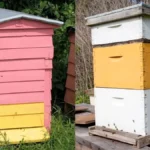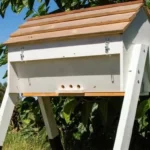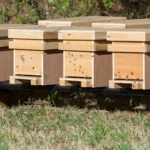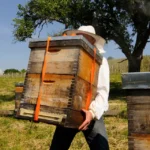When it comes to beekeeping, getting your deep hive body dimensions right is critical to getting a Langstroth hive to work properly. Bee space is the foundation upon which trouble-free beekeeping is built. If you get your Langstroth hive constructed to the right beehive dimensions, your beekeeping will be largely trouble-free and fun. Incorrect deep hive body dimensions, or any part of the hive that is not built with bee space in mind, invites a world of irritation and pain into your life. In this article, we take a closer look at bee box dimensions.
Bee Space
When you first look at a beehive, it looks simple. It is basically a box with some frames in it, a lid, and a bottom board. Then you look at the price of a properly made beehive and you fall over backward. How can that little box cost that much?
A beehive is a piece of precision agricultural equipment. The box is built around the principle of bee space. If you get a measurement wrong, it will work less well.
Bee space is defined as a specific space dimension that bees will not build comb in. Quite simply, this is the distance between the surface of two combs in a hive. The space measures about 5/16th of an inch (8mm). Depending on the race or breed of bee this may vary a bit.
From the perspective of a bee, if she cannot get into a space to police it or clean it, that space could harbor pests. She will seal the space off to limit risk. If she can crawl into the space and police it, but the space is too small to build combs she will leave it open. Large spaces will be filled with comb.
How We Use Bee Space In A Deep Brood Box and Other Parts Of The Hive
Every part of the hive must employ bee space in its design. This means that a Langstroth hive will be built around a standard set of dimensions. Frames need to employ bee space. The distance between the frames and the side of the box needs to employ bee space and even the distance between the bottom of the frames and the next box needs to employ bee space.
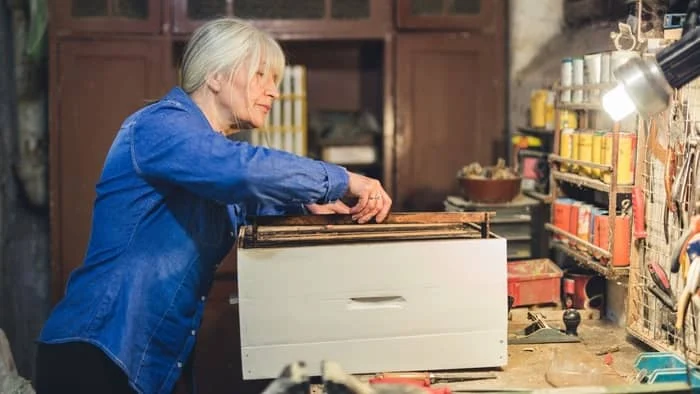
Learn more about: When To Add Supers To Beehives?
A Langstroth Like Box – A Disaster
When I started keeping bees, I just found an old beehive box and then using a jigsaw and some old floorboards, a chisel, and a hammer, I built ten beehives. These were the worst beehives I have ever seen. They were horrible to use, and they taught me a lot of important lessons.
Lesson One – Do Not Use Second-Hand Wood
Floorboards recovered from old buildings have no service book that comes with them explaining what has happened in their lives. You do not know if they were treated with arsenic (popular up to the 1950s), painted PCP type wood preservative (popular until the 1980s), or have lead paint on them (popular up until the 1990s).
Buy virgin untreated wood if you are going to make your own hives.
Lesson Two – Cumulative Error
I took bad measurements off a hive that had been to hell and back. This was a beaten-up old beehive that had been around since the 1930s. It was actually made by AI Roodt company. So it was an excellent hive – but even a 60-year-old Rolls Royce gets tired.
Every time we make something, small errors creep in. If we then take measurements off the thing we have made, and use those to make the next thing, eventually, we get an accumulation of measurement errors and the results can be a significant deviation from the correct dimensions.
Never measure off a beehive and use those measurements to make a box. Always use a cutting list that is new, and correct. There are many excellent cutting lists out there such as this one and if you have a simple workshop – this one.
Lesson Three – What Happens When You Get The Dimensions Wrong
I got my first deep hive body dimensions wrong on 10 beehives. When you make a mistake like this, the bees glue the whole hive together – you cannot get the frames out without breaking the frames. Then honey pours all over the bees. This results in robbing and chaos.
Eventually, after two years of these cursed hives, I actually bought new, properly dimensioned hives, and then I took a crowbar, broke the old hives open and removed the frames, and transferred them to the new hives. It was a huge amount of work, and the time, lost production, and irritation dwarfed the money I “saved” by making my own bad hives.
Lesson Four – Do It Once, Do It Right
I have now learnt that if I am making hive parts, I aim to do it once, and do it right. I am 45 now – if I do this, the beehive parts I make now will see me through to when I am unable to work bees anymore. If I follow in the footsteps of one of my bee mentors, Mr. Hadley Timm, that means until I am 90. Although he has not stopped. Bees put a spring in the step of person.
Recommendations For Your First Hives
Buy Boxes
I would strongly recommend that your first hives are bought boxes. If you plan to make your own, rather use bought, high-quality hives. Learn how they work, and then based on this experience make your own.
Be very wary when buying old second-hand boxes – take an accurate measure – I actually use a digital caliper to measure the bee space gaps and a steel ruler. Check the measurements against a drawing of a hive.

I have had the case where I bought a set of hives from a guy. He made all his own hives and his bee space was perfect for his hives, but they were his own design. His frames were even his own size. Then we got these all mixed into the rest of our operation and for years they caused problems until we managed to get rid of the lot of the equipment.
We hope this article has helped you understand the absolute importance of metrology and sticking to the exact dimensions of a Standard Langstroth hive in your beekeeping. Please share, and learn from all my stupid mistakes, so you don’t make those. Make your own new stupid mistakes instead! That is progress.
Read more about: How Much Do Beehives Cost?
Deep Hive Dimension FAQs
1. What are the standard dimensions of a deep hive body?
A deep hive body, commonly used in Langstroth hives, typically measures 19 7/8 inches in length, 16 1/4 inches in width, and 9 5/8 inches in height. These dimensions ensure proper spacing for the bees to build comb and function efficiently within the hive.
2. Why is bee space important in hive construction?
Bee space refers to a gap between 1/4 to 3/8 inch (approximately 6-10 mm) that bees use to navigate and maintain their hive. If bee space is too small or too large, bees may either propolize (seal with resin) or build comb in the space, leading to poor hive functionality and increased maintenance for beekeepers.
3. Can I make my own deep hive bodies?
Yes, you can build your own deep hive bodies. However, it’s crucial to follow precise dimensions and maintain accurate bee space to prevent issues such as propolizing or excessive comb building, which can make hive management difficult.
4. What happens if deep hive body dimensions are incorrect?
If the deep hive body dimensions are off, it can lead to problems like frames sticking together, comb being built in undesirable places, and difficulty removing frames. This increases the chance of damaging the hive and causing stress to the bees during routine inspections.
5. What type of wood should I use for hive construction?
When building hive bodies, it is recommended to use untreated, kiln-dried pine or other softwoods. Avoid using second-hand wood as it may contain chemicals harmful to bees. Properly dried wood also reduces the risk of warping and maintaining consistent dimensions over time.
6. How does cumulative error affect hive body construction?
Cumulative error occurs when small measurement inaccuracies add up over time, leading to larger deviations in hive construction. Always use an accurate cutting list and avoid measuring from previously built hive bodies to prevent errors.
7. What tools are recommended for measuring hive dimensions?
For accurate hive construction, use a steel ruler, digital calipers, and a precise cutting guide. These tools help ensure that all hive components are made to exact specifications, maintaining proper bee space and alignment.
8. Can I buy pre-made deep hive bodies?
Yes, purchasing pre-made hive bodies from a reputable supplier is often the best choice for beginners. This ensures that you start with properly dimensioned equipment, reducing the chance of hive management problems caused by poorly constructed hives.
9. Are there different sizes of hive bodies in beekeeping?
Yes, besides deep hive bodies, there are also medium and shallow hive bodies. Deep hive bodies are commonly used for the brood chamber, while medium and shallow hive bodies are often used for honey supers.
10. How do I know if my deep hive body dimensions are correct?
Measure the distance between the frames, box sides, and bottom board. If these spaces follow the standard bee space of 1/4 to 3/8 inch, your hive body is likely constructed correctly. Regular inspections of the hive’s internal structure can also reveal if bees are encountering space-related issues.

Dr. Garth A. Cambray is a Canadian/South African entrepreneur and beekeeper with 28 years of experience in apiculture and specializes in adding value to honey. His Ph.D. research developed a new advanced continuous fermentation method for making mead that has resulted in a number of companies globally being able to access markets for mead. His company, Makana Meadery, exports honey mead to the USA where it is available to discerning connoisseurs. He has also developed technologies to commercially manufacture organic honey vinegar in Zambia for export globally. He holds a few patents globally in the ethanol industry and believes in technology and knowledge transfer for human development and environmental sustainability. One of his proudest achievements is the fact that the wind farm he started at one of his old apiary sites has essentially made his hometown carbon neutral.

